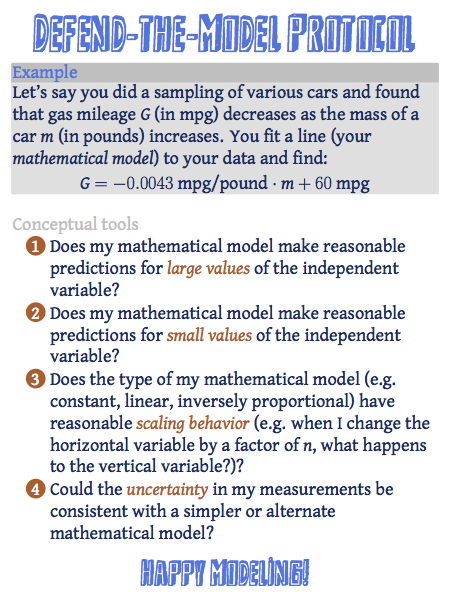Following David Hestenes on page 6 of Modeling Instruction for STEM Education Reform, I wanted to create a poster like in my previous post of graphical methods and linearizing graphs but this time about the basic classes of mathematical models that Hestenes lists. I’m not sure that I like all the equation gobbledegook, but I think students need something to which to aspire, so I just made it less prominent. I’d also like a better presentation of some of the equations.

mathematical-models-B-beamer-poster-18×24
Update: You can now find source code for this and other posters in my GitHub repository.
\documentclass[final]{beamer} % beamer 3.10: do NOT use option hyperref={pdfpagelabels=false} !
%\documentclass[final,hyperref={pdfpagelabels=false}]{beamer} % beamer 3.07: get rid of beamer warnings
\mode<presentation> { %% check http://www-i6.informatik.rwth-aachen.de/~dreuw/latexbeamerposter.php for examples
\usetheme{default} %% you should define your own theme e.g. for big headlines using your own logos
\beamertemplatenavigationsymbolsempty
\definecolor{royalblue}{rgb}{0,0.13725490196078433,0.4}
\definecolor{royalblueweb}{rgb}{0.25490196078431371,0.41176470588235292,0.88235294117647056}
\definecolor{burntorange}{rgb}{0.8,0.3333333333333333,0}
\setbeamercolor{frametitle}{fg=blue!80!black}
\setbeamertemplate{frametitle} {
\begin{center}
\vspace{-1.2cm}\textbf{\insertframetitle} \par
\normalsize\textbf{\insertframesubtitle}
\end{center}
}
}
\usepackage[english]{babel}
\usepackage[latin1]{inputenc}
\usepackage{amsmath,amsthm, amssymb, latexsym}
%\usepackage{times}\usefonttheme{professionalfonts} % times is obsolete
\usefonttheme[onlymath]{serif}
\boldmath
%\usepackage[orientation=portrait,size=a0,scale=1.4,debug]{beamerposter} % e.g. for DIN-A0 poster
%\usepackage[orientation=portrait,size=a1,scale=1.4,grid,debug]{beamerposter} % e.g. for DIN-A1 poster, with optional grid and debug output
\usepackage[size=custom,width=45.72,height=60.96,scale=1.8,debug]{beamerposter} % e.g. for custom size poster (18in x 24in w/ printable 17in x 23in)
%\usepackage[orientation=portrait,size=a0,scale=1.0,printer=rwth-glossy-uv.df]{beamerposter} % e.g. for DIN-A0 poster with rwth-glossy-uv printer check
% ...
%
\geometry{margin=.5in}
\usepackage{array}
\usepackage{booktabs}
\newcolumntype{P}[1]{>{\raggedright\large}p{#1}}
\def\imagetop#1{\vtop{\vspace{-1.5cm}\null\hbox{#1}\vspace{-1.5cm}}}
\usepackage{tikz}
\newcommand{\xx}{\textcolor{variable}{x}}
\newcommand{\yy}{\textcolor{variable}{y}}
\newcommand{\versus}{vs\ }
\newcommand{\plotscale}{2.0}
\newcommand{\plotline}{6pt}
\newcommand{\formatmm}[1]{\textcolor{royalblue}{\textbf{#1}}}
\colorlet{plot}{burntorange}
\colorlet{variable}{blue!80!black}
% From Hestenes' list of 4 basic mathematical models
\title[Mathematical Models]{Basic Classes of Mathematical Models}
\author[Vancil]{Brian Vancil}
\institute[Sumner]{Sumner Academy of Arts & Sciences}
\date{2012-04-07}
\begin{document}
\begin{frame}{Basic Classes of Mathematical Models}
\framesubtitle{with sample equations}
\defaultaddspace=.25em
\vspace{-2cm}
\begin{center}
\begin{tabular}{P{.45\linewidth}P{.29\linewidth}@{\quad}>{\arraybackslash}P{.19\linewidth}} \toprule[.1em]
\normalsize Mathematical model & \normalsize Kind of change & \normalsize Graph shape \\ \midrule[.1em] \addlinespace
\formatmm{Linear model}
\par \normalsize $\yy=A\xx+B$
\par $\dfrac{d\yy}{d\xx}=A$ &
Rate of change is constant. &
\imagetop{\begin{tikzpicture}[scale=\plotscale,domain=0:4,line width=\plotline,smooth]
\draw[color=plot] plot (\x,.6*\x+1);
\draw[<->] (0,4) -- (0,0) -- (4,0);
\end{tikzpicture}}
\\ \addlinespace \midrule \addlinespace
\formatmm{Quadratic model}
\par \normalsize $\yy=A\xx^{2}+B\xx+C$
\par $\dfrac{d^{2}\yy}{d\xx^{2}}=A$ &
Rate of change of rate of change is constant. &
\imagetop{\begin{tikzpicture}[scale=\plotscale,domain=0:4,line width=\plotline,smooth,samples=40]
\draw[color=plot] plot (\x,{4-0.7*(\x-2)*(\x-2)});
\draw[<->] (0,4) -- (0,0) -- (4,0);
\end{tikzpicture}}
\\ \addlinespace \midrule \addlinespace
\formatmm{Exponential model}
\par \normalsize $\yy=Ab^{\xx}$ or $\yy=Ae^{\frac{\xx}{\xi}}$
\par $\dfrac{d\yy}{d\xx}=\ln b\cdot\yy$ or $\dfrac{d\yy}{d\xx}=\frac{\yy}{\xi}$ &
Rate of change is proportional to amount. &
\imagetop{\begin{tikzpicture}[scale=\plotscale,domain=0:4,line width=\plotline,smooth,samples=40]
\draw[color=plot] plot (\x,{pow(pow(4,.25),\x)});
\draw[<->] (0,4) -- (0,0) -- (4,0);
\end{tikzpicture}}
\\ \addlinespace \midrule \addlinespace
\formatmm{Harmonic model}
\par \normalsize $\yy=A\cos\left(k\xx+\phi\right)$ or $\yy=A\sin\left(k\xx+\phi'\right)$ or $\yy=\mathfrak{Re}\left\{Ae^{i(k\xx+\phi)}\right\}$
\par $\dfrac{d^{2}\yy}{d\xx^{2}}=-k^{2}\yy$ &
Rate of change of rate of change is proportional to amount. &
\imagetop{\begin{tikzpicture}[scale=\plotscale,domain=0:4,line width=\plotline,smooth,samples=40]
\draw[color=plot] plot (\x,{2*cos((\x*6.28-1)r)});
\draw[->] (0,-2) -- (0,2);
\draw[->] (0,0) -- (4,0);
\end{tikzpicture}}
\\ \addlinespace \midrule \addlinespace
\formatmm{Sudden change model}
\par \normalsize $\yy=A\ \theta(\xx-x_{0})+B$
\par $\dfrac{d\yy}{d\xx}=A\ \delta(\xx-x_{0})$ &
Change is finite and instantaneous. &
\imagetop{\begin{tikzpicture}[scale=\plotscale,domain=0:4,line width=\plotline,smooth,samples=40]
\draw[color=plot, domain=0:2] plot (\x,1);
\draw[color=plot, domain=2:4] plot (\x,3);
\draw[<->] (0,4) -- (0,0) -- (4,0);
\end{tikzpicture}}
\\ \addlinespace
\bottomrule[.1em]
\end{tabular}
\end{center}
\end{frame}
\end{document}


